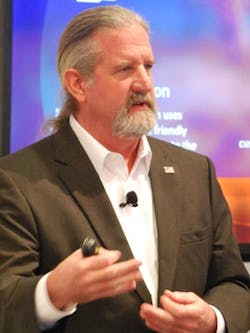Today’s automation equipment holds the potential to provide data that can extend an asset’s useful life, reduce downtime, optimize performance and even turn expenses into new profit sources. All of this can mean millions of dollars in savings and revenue. The goal of GE and its remote monitoring and diagnostics offering is to release that potential and help equipment end users and OEMs realize those benefits.
Today at GE's Minds + Machines Conference in San Francisco, Steve Pavlosky, Equipment Insight solution leader, encouraged end users and OEMs to break down perceived obstacles that are keeping companies from benefiting from connectivity and remote monitoring.
Equipment Insight is an end-to-end remote monitoring and diagnostics solution specifically designed for OEMs. It provides a secure, robust and convenient means of keeping an eye on installed assets and enables OEMs to quickly address customer issues by delivering the right information to the right person, wherever they are, and on any device.
“Entry into the Internet of Things doesn’t have to be overwhelming; ubiquitous connectivity and the cloud make it easy and cost effective to get started,” Pavlosky told the audience of OEMs and end users.
Pavlosky level-set the presentation by asking his audience how many of them believed the Industrial Internet of Things would have an impact on the way they do business five years from now. Using their smartphones to answer, 83% of the audience said IIoT would have a “high” or “critical” impact. Asked how many had a strategy in place to institute IIoT measures, 50% reported having an informal strategy and 20% said they have no strategy in place.
“This shows you the dichotomy of where we are,” Pavlosky said. “People understand that [the IIoT] is important, but they don’t necessarily know where to get started. The good news is that this is not technology that’s coming. We already have the tools we need to quickly help our customers get more out of the equipment they purchase.”
In fact, Pavlosky said, the smartphones the audience used to answer his questions are a primary driver of this new connectivity. “The face of automation is changing,” Pavlosky said. “It’s going to become a lot younger, and these younger workers expect to find the same access and connectivity at work that they enjoy in the rest of their lives.”
Perceived obstacles
Despite this simplicity, there are key perceived obstacles that need to be addressed before industry is fully ready to connect, Pavlosky said. These include perceptions about integration complexity and cost; resources and security concerns. Yet all of these perceptions are just that—perceptions—Pavlosky said.
"You’ll be amazed at how simple it can be, and how much potential is there.” TempuTech's Adrian Merrill on GE's Equipment Insight offering for remote monitoring and diagnostics.
On the OEM side, many small to midsized OEMs believe it is beyond their capability or expertise to offer advanced remote monitoring and predictive maintenance services on their machines. In fact, the confluence of plug-and play connected field monitoring equipment, secure Internet-enabled cloud computing, simple data analysis tools, and subscription-based monitoring services has put this crucial capability within reach of all machine builders. And, Pavlosky said, OEMs should prepare for end users to start asking for it.
"In many cases, it is the end users that need to be convinced first,” Pavlosky said. “OEMs tell me, ‘Our customers will never give us access to the information in their machines,’ but we see manufacturers who are coming to GE and asking us to provide this service. And now our OEM customers are telling us that they are hearing the same requests.”
In fact, Equipment Insight is the result of remote monitoring systems that GE developed for the equipment it built for its own customers, Pavlosky said. “The fact that Equipment Insight has the GE name behind it, that alone can go a long way in breaking down obstacles,” he said.
Adoption drivers
Worldwide, manufacturers are under ever increasing pressure to compete in a market whose workforce and technology are being revolutionarily transformed. It is estimated that as much as 40% of the existing skilled manufacturing workforce will retire by 2020. Vast stores of knowledge essential to efficient plant operation will leave along with these educated workers. In response, manufacturers are seeking ways to limit the impact of this resource drain, and it is certain that many vacated positions will not be filled. Manufacturers are looking to technology—and their OEMs—to fill the void by providing tools for improved efficiency, productivity and profitability.
Add to this the explosion in the number of connected machines in factories and increased pressure on manufacturer CIOs to run more efficient operations through effective data analysis, and you have the makings of a radical transformation in the way manufacturing business is conducted. With connected machines, manufacturers expect to be able to do more with fewer resources; and that means they will be replacing only a small percentage of the positions that will be opened up through retirement.
In this new paradigm, manufacturers are already putting pressure on OEMs to provide solutions. Machine builders who can answer this challenge stand to benefit from long-term customer satisfaction and loyalty as well as streamlined product development, improved product insights and new revenue streams.
Case study: Global Drilling Support
Two case studies were presented by OEMs who have integrated Equipment Insight into installations, and each reported significant benefits.
Global Drilling Support < http://www.globaldrillingsupport.com/> designs and manufactures top drives for oil drills, as well as providing repair, recertification and other services to the oil drilling industry. Keith Holliday, president of Global Drilling Support recounted his experience integrating Equipment Insight on the company’s top drives.
Top drives, which cost $1.5M to $3M, are the part of the drill rig that actually drills the well. “The top drive is a single source of downtime,” Holliday said. “When the top drive isn’t operating, the rig isn’t operating.”
Top drives have a service life of five years before they need to be torn down, rebuilt and recertified. “They are drilling only a fraction of the time they are on the well, but until now there’s been little quantification on that,” Holliday said. By incorporating Equipment Insight, GDS has been able to provide real guidance on when to service the unit.
GDS collects the information in the top drive’s PLC, but Holliday said the company had trouble getting the information out. Oil rigs tend to be inhospitable environments spread all over the world, Holliday said, adding to the challenge. “Often when we would get out there we’d find a sensor was jumpered or we had a nuisance alarm, so over time we lost that information. What we needed was away to monitor the data on a day-to-day basis.”
GDS installed Equipment Insight on two rigs as a pilot program. The company can now quantify information that helps rigs run better, reduce downtime, control costs and increase revenue. “Our goal is 100-percent uptime for our customers, and this brings us much closer to making that a reality,” Holliday said.
Case study: TempuTech
Adrian Merrill, CTO and vice president, corporate development, TempuTech, began using the product that is now Equipment Insight in 2013. TempuTech monitors grain in storage for temperature and humidity, two critical variables in maintaining the grain’s value and safety, since improper temperature and humidity can cause dormant grain to germinate, ruining its value and potentially causing a fire or explosion in the facility.
Merrill said that monitoring with Equipment Insight has not just improved TempuTech’s ability to protect its customers’ products and safety, but it has actually enabled the company to condition its customers’ grain so that it gets top dollar. “So I have taken safety, something that was an expense category, and I’ve moved it over to a profit category. That makes it a lot easier for a customer to justify from a money standpoint.”
Merrill encouraged OEMs and end users to work together to overcome the perceived obstacles to this new way of doing business that provides benefits for both. “If you’re stuck on how to get started, just pick one small project and bring it to the people at Equipment Insight to get their guidance. You’ll be amazed at how simple it can be, and how much potential is there.”
You can see the full TempuTech case study in the Control Design Special Report: The Machine Builder’s Guide to Remote Monitoring. This free ebook provides an overview of remote monitoring and explains how even the smallest OEM can improve performance, fast-track machine development, reduce costs, and increase revenues and customer satisfaction by integrating remote monitoring into their machines. It includes a compilation of popular remote monitoring articles from the archives of Control Design and the TempuTech case study.

Leaders relevant to this article:






